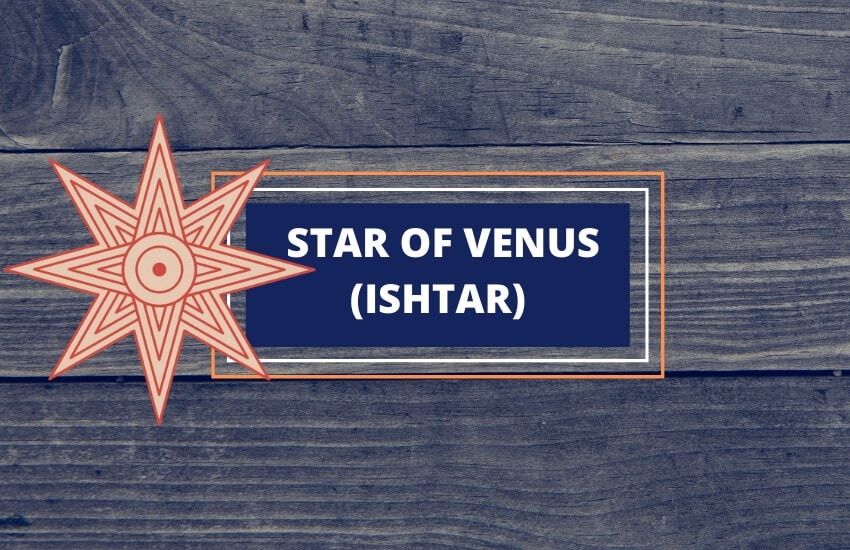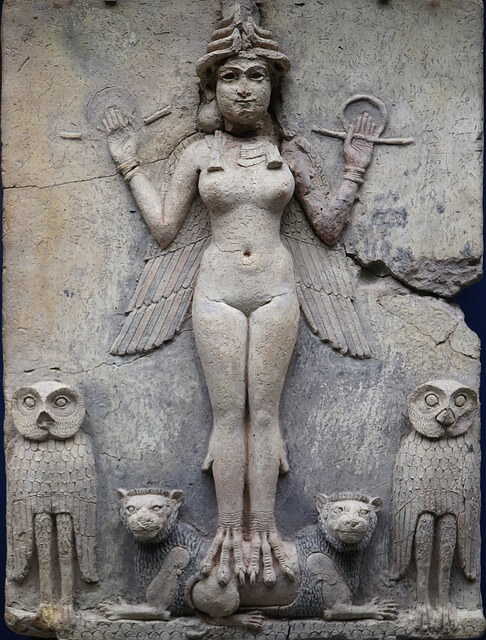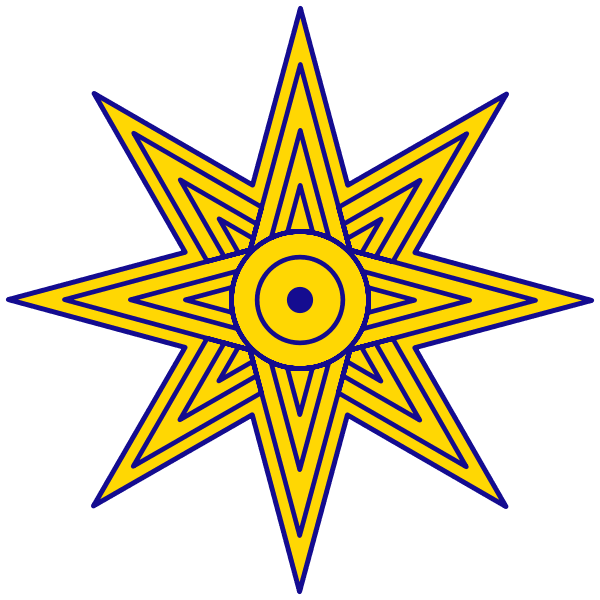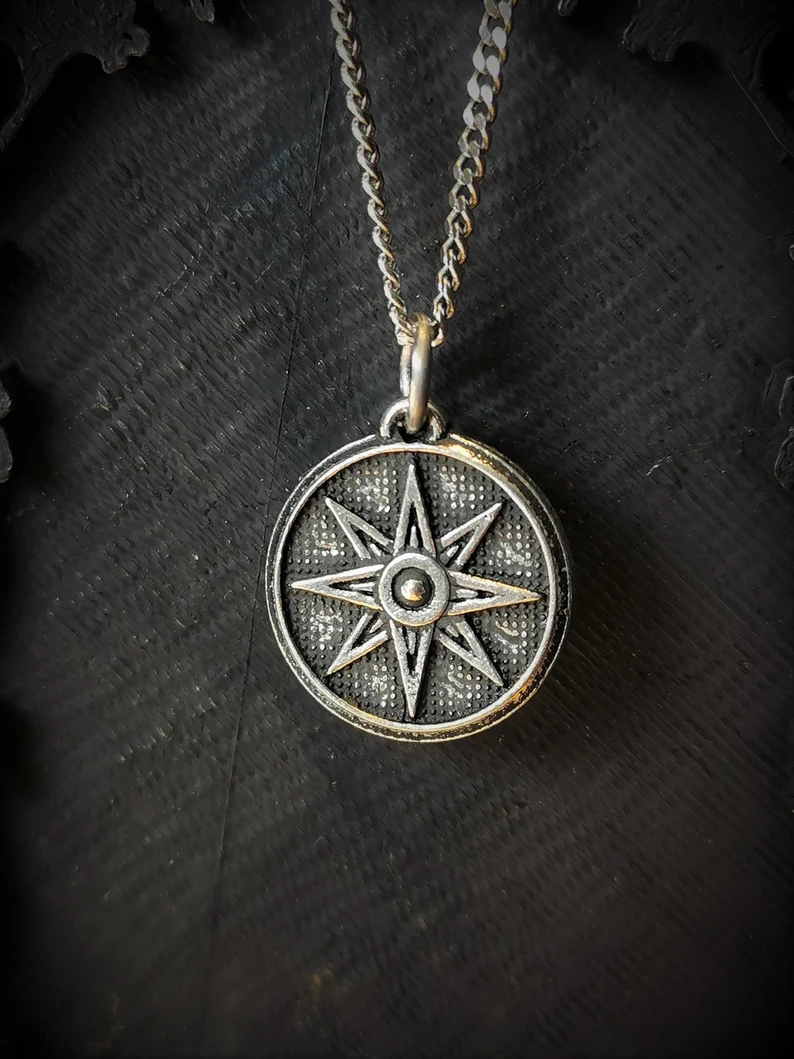
Table of Contents
The Star of Venus, also known as the Star of Inanna or the Star of Ishtar, is a symbol most commonly associated with the Mesopotamian goddess of war and love, Ishtar. The ancient Babylonian deity Ishtar’s Sumerian counterpart was the goddess Inanna.
The eight-pointed star is one of the most predominant symbols of Ishtar, next to the lion. The goddess was also often connected to the planet Venus. Therefore, her star symbol is also known as the Star of Venus, and Ishtar is sometimes referred to as the Morning and the Evening Star Goddess.
Ishtar Goddess and Her Influence

In the Sumerian pantheon, the most prominent deity, the goddess Inanna, became associated with Ishtar, due to their unique similarities and the shared Semitic origin. She’s the goddess of love, desire, beauty, sex, fertility, but also war, political power, and justice. Originally, Inanna was worshiped by Sumerians, and later by Akkadians, Babylonians, and Assyrians, under the different name – Ishtar.
Ishtar was also widely known as the Queen of Heavens and was considered the patron of the Eanna Temple. The temple was located in the city of Uruk, which later became Ishtar’s main devotion center.
1. Sacred Prostitution
This city was also known as the city of divine or sacred prostitutes since sexual acts were considered sacred rituals in Ishtar’s honor, and the priestesses would offer their bodies to the men for money, which they later would donate to the temple. For this reason, Ishtar was known as the protector of brothels and prostitutes and was a symbol of love, fertility, and reproduction.
2. External Influence
Later, several Mesopotamian civilizations adopted prostitution as a type of worship from Sumerians. This tradition was ended in the 1st century when Christianity emerged. However, Ishtar remained an inspiration and influence for the Phoenician goddess of sexual love and war, Astarte, as well as the Greek goddess of love and beauty, Aphrodite.
3. Association with Planet Venus
Just like the Greek goddess Aphrodite, Ishtar was commonly associated with the planet Venus and was considered a celestial deity. It was believed that she was the daughter of the moon god, Sin; other times, she was believed to be the offspring of the sky god, An or Anu. Being the daughter of the god of the sky, she’s often associated with thunder, storms, and rain, and was depicted as a lion roaring thunderbolts. From this connection, the goddess was also connected to great power in war.
The planet Venus appears as a star in the morning sky and the evening, and for this reason, it was thought that the goddess’ father was the moon god, and that she had a twin brother Shamash, the Sun god. As Venus travels across the sky and changes from the morning into the evening star, Ishtar was also associated with the goddess of morning or morning virgin, symbolizing war, and with the goddess of evening or night prostitute, symbolizing love and desire.
The Symbolic Meaning of the Star of Ishtar


The lion of Babylon and eight-pointed stars are the most prominent symbols of the goddess Ishtar. Her most common symbol, however, is the Star of Ishtar, which is usually depicted as having eight points.
Originally, the star was associated with the sky and heaven, and the goddess was known as the Mother of the Universe or The Divine Mother. In this context, Ishtar was seen as the sparkling light of the primordial passion and creativity, symbolizing life, from birth to death.
Later, by the Old Babylonian period, Ishtar became explicitly identified and associated with Venus, the planet of beauty and pleasure. Hence the Star of Ishtar is also known as the Star of Venus, representing passion, love, beauty, balance, and desire.
Each of the eight rays of the Star of Ishtar, called the Cosmic Rays, corresponds to a particular color, planet, and direction:
- The Cosmic Ray 0 or 8th points to the North and represents the planet Earth and the colors white and rainbow. It symbolizes femininity, creativity, nourishment, and fertility. The colors are seen as the symbols of purity as well as unity and connection between the body and the spirit, the Earth, and the universe.
- The Cosmic Ray 1st points to the Northeast and corresponds to the planet Mars and the color red. It represents willpower and strength. Mars, as the red planet, symbolizes fiery passion, energy, and perseverance.
- The Cosmic Ray 2nd corresponds to the East, the planet Venus, and the color orange. It represents creative potency.
- The Cosmic Ray 3rd points to the Southeast and refers to the planet Mercury and the yellow color. It represents awakening, the intellect or the higher mind.
- The Cosmic Ray 4th refers to the South, Jupiter, and the green color. It symbolizes harmony and inner balance.
- The Cosmic Ray 5th points to the Southwest and corresponds to the planet Saturn, and the color blue. It symbolizes inner knowledge, wisdom, intelligence, and faith.
- The Cosmic Ray 6th corresponds to the West, the Sun as well as Uranus, and the color indigo. It symbolizes perception and intuition through great devotion.
- The Cosmic Ray 7th points to the Northwest and refers to the Moon as well as the planet Neptune, and the color violet. It represents the deep spiritual connection to the inner self, great psychic perception, and awakening.
Additionally, it’s thought that the eight points of the Star of Ishtar represent the eight gates surrounding the city of Babylon, the capital city of the ancient Babylonia. The Ishtar Gate is the main gate of these eight and an entrance to the city. The doors of the walls of the Babylon were dedicated to the most prominent deities of the ancient Babylonian kingdom, symbolizing the splendor and power of the most significant city of that time.
Star of Ishtar and Other Symbols
The slaves who were employed and worked for the temple of Ishtar were occasionally marked with the seal of the Ishtar’s eight-pointed star.
This symbol was often accompanied by the crescent moon symbol, representing the moon god Sin and solar ray disc, the symbol of the Sun-god, Shamash. These were often engraved together in the ancient cylinder seals and boundary stones, and their unity represented the three gods or the trinity of Mesopotamia.
In more modern times, the Star of Ishtar usually appears alongside or as a part of the solar disc symbol. In this context, Ishtar, together with her twin brother, the sun god Shamash, represents the divine justice, truth, and morality.
Originally the symbol of Inanna, the rosette was an additional symbol of Ishtar. In the Assyrian period, the rosette became more important than the eight-pointed star and the primary symbol of the goddess. The images of the flower-like rosettes and the stars embellish the walls of the Ishtar’s temple in some cities, such as Aššur. These images portray the goddess’s contradicting and enigmatic nature since they capture both the subtle fragility of the flower as well as the intensity and power of the star.
To Wrap Up
The beautiful and mysterious Star of Ishtar represents the goddess who was associated with both love and war and hides various dualistic and paradoxical meanings. However, we can conclude that, on a more spiritual level, the eight-pointed star is deeply connected to the divine traits, such as wisdom, knowledge, and the awakening of the inner self.








